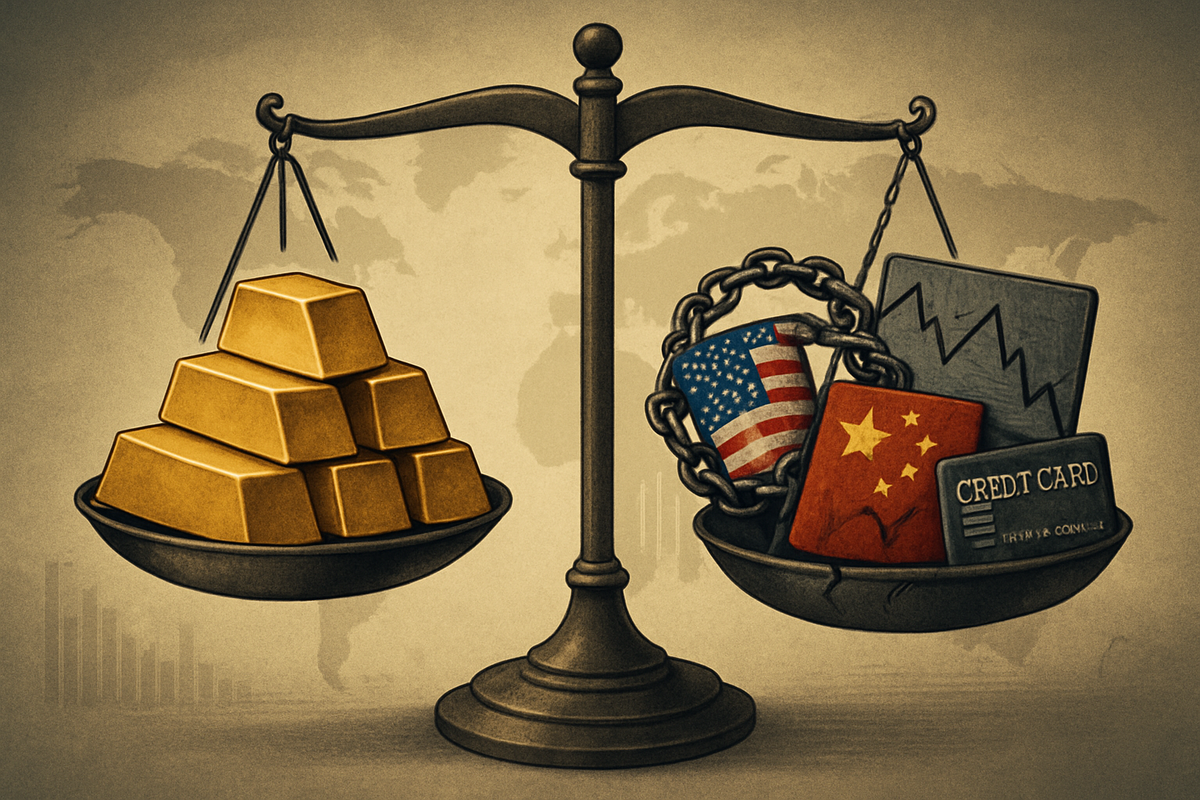
Gold prices have recently shown a notable resilience, holding steady after a period of significant volatility, as global financial markets fixate on two primary drivers: the ever-evolving US-China trade relations and lingering concerns within the credit sector. This delicate balance of geopolitical maneuvering and economic vulnerabilities has created a complex environment for the precious metal, diminishing its immediate safe-haven appeal while underlying bullish factors continue to simmer. The current stability, following a sharp pullback from recent highs, underscores a cautious optimism among traders, who are closely monitoring diplomatic progress and the health of financial institutions.
The immediate implications for gold are a direct reflection of these intertwined market dynamics. A recent softening of rhetoric from Washington regarding trade tariffs and the resumption of high-level US-China trade talks have temporarily reduced the urgency for safe-haven assets, contributing to gold's current holding pattern. Simultaneously, while credit market jitters persist following a series of alarming events, improved sentiment towards regional banks has somewhat lessened the immediate demand for gold as a hedge against widespread financial instability. However, analysts maintain that gold's broader trend remains structurally bullish, supported by global fiscal strains, ongoing policy uncertainties, and the potential for future Federal Reserve rate cuts.
Unpacking the Market's Driving Forces
Gold's recent journey has been a rollercoaster, surging to an unprecedented $4,379 per ounce on October 17, 2025, marking its largest weekly gain since the 2008 financial crisis. This meteoric rise was fueled by a confluence of safe-haven demand amidst escalating credit fears and renewed US-China trade tensions. However, by October 20, the precious metal had settled, with COMEX gold trading around $4,242.5 per troy ounce and spot gold at $4,238.58 per ounce, reflecting a modest increase or a holding of its earlier drop. This stabilization followed comments from President Trump, signaling a potential softening stance on trade tariffs, which injected a dose of optimism into the markets.
The backdrop to this volatility is a period of intense economic decoupling between the United States and China throughout October 2025. On October 10, President Trump announced plans for an additional 100% tariff on Chinese imports, effective November 1, threatening to push effective rates as high as 130-145% in certain sectors. The US further tightened its grip with new export controls targeting "critical software." China swiftly retaliated on October 9, expanding its export controls on rare earth elements—a sector where it commands 85% to 90% of global processing capacity—and imposing sanctions on US subsidiaries. This tit-for-tat escalation erased over $1.5 trillion in market value within just two days, sending shockwaves across global bourses. However, a "pause" emerged by the end of last week, with President Trump acknowledging the proposed 100% tariff as "not sustainable" and expressing optimism for upcoming talks with Chinese President Xi Jinping. US Treasury Secretary Scott Bessent is slated to meet with Chinese Vice-Premier He Lifeng in Malaysia this week for new trade negotiations, offering a glimmer of hope for de-escalation.
Compounding the trade tensions are persistent vulnerabilities within the credit markets. October 2025 saw significant apprehension following the bankruptcies of automotive finance provider Tricolor and auto parts manufacturer First Brands, which had ripple effects on major financial institutions. Regional banks, notably Zions Bancorp (NASDAQ: ZION) and Western Alliance Bancorp (NYSE: WAL), disclosed substantial issues with bad loans and alleged fraud, leading to sharp declines in their share prices. JPMorgan Chase & Co. (NYSE: JPM) CEO Jamie Dimon publicly warned of potential "cockroaches" in the credit market, suggesting broader underlying problems and contributing to a spike in the Cboe Volatility Index (VIX) to 25, its highest since April-May 2025. While solid earnings reports from some regional lenders later in the week helped to alleviate immediate fears, questions linger about the systemic nature of these credit woes, particularly given the rapid growth in collateralized loan and private credit markets.
Corporate Fortunes in the Balance
The interplay of trade dynamics and credit stability has distinct implications for various public companies. Gold mining companies, such as Barrick Gold (NYSE: GOLD) and Newmont Corporation (NYSE: NEM), are directly affected by the volatility in gold prices. While the recent surge to record highs boosted their revenue outlooks, the subsequent pullback and current stabilization mean that sustained high prices are not guaranteed. These companies benefit from strong safe-haven demand, and any prolonged de-escalation of global tensions could temper their upside, although the underlying bullish sentiment for gold as a long-term hedge remains.
Financial institutions, especially regional banks, find themselves at the epicenter of the credit market concerns. Zions Bancorp (NASDAQ: ZION) and Western Alliance Bancorp (NYSE: WAL), having revealed issues with bad loans and alleged fraud, face heightened scrutiny and potential regulatory action. Their ability to contain these problems and restore investor confidence will be crucial for their stock performance and overall stability. Larger institutions like JPMorgan Chase & Co. (NYSE: JPM), while seemingly more resilient, are not immune to systemic credit shocks, as CEO Jamie Dimon's warning suggests. A widespread credit contagion could impact their lending portfolios and investment activities.
Companies heavily reliant on global supply chains and US-China trade are also in a precarious position. Technology giants, automotive manufacturers, and consumer goods companies with significant exposure to both markets face ongoing uncertainty. While a pause in tariff escalation offers temporary relief, the long-term trend of "economic decoupling" suggests a need for strategic diversification of supply chains and manufacturing bases. Companies like Apple Inc. (NASDAQ: AAPL), which has extensive manufacturing in China, or semiconductor firms like NVIDIA Corporation (NASDAQ: NVDA), which navigate complex export controls, must adapt to a potentially fragmented global economy. Conversely, companies that can quickly re-shore production or find alternative markets may emerge as relative winners in this evolving trade landscape.
Wider Significance and Historical Echoes
This current market environment, characterized by fluctuating gold prices, trade tensions, and credit concerns, fits into broader industry trends of deglobalization and heightened geopolitical risk. The "economic decoupling" between the US and China is not merely a tariff war but a strategic repositioning that will likely redefine global supply chains for decades. This trend encourages nations and corporations to reduce reliance on single-source suppliers, leading to significant investments in diversified manufacturing bases and localized production. The ripple effects extend to shipping companies, logistics providers, and even technology infrastructure developers, as they adapt to new trade routes and data flow restrictions.
Regulatory and policy implications are substantial. Governments worldwide are likely to review trade agreements, export control policies, and financial oversight mechanisms. The vulnerabilities exposed in regional banks could lead to stricter capital requirements or enhanced stress tests, particularly for institutions with significant exposure to high-risk loan portfolios or private credit markets. On the trade front, while immediate talks offer a reprieve, the underlying strategic competition could lead to new bilateral agreements or the formation of trade blocs, further fragmenting the global economy.
Historically, periods of intense geopolitical rivalry and economic uncertainty have often seen gold perform strongly as a safe-haven asset. Comparisons can be drawn to the 1970s oil shocks or the 2008 financial crisis, where gold's appeal surged amidst inflation fears and systemic risks. However, the current situation is unique due to the simultaneous forces of a global pandemic recovery, unprecedented fiscal stimulus, and the intricate web of modern financial instruments. The easing of trade tensions, even if temporary, provides a counter-narrative to the safe-haven thesis, demonstrating how quickly market sentiment can pivot on diplomatic signals.
The Road Ahead: Navigating Uncertainty
Looking ahead, the short-term trajectory of gold prices and market stability will largely hinge on the outcomes of the upcoming US-China trade negotiations. A significant breakthrough could further dampen safe-haven demand for gold, potentially leading to additional profit-taking. Conversely, any renewed escalation of tensions or a failure to reach common ground could quickly reignite gold's appeal, pushing it back towards or even beyond its recent record highs. Similarly, the containment of credit market issues, particularly within regional banks, will be critical. If these prove to be isolated incidents, broader market confidence could solidify; however, if they signal systemic fragility, a more significant financial downturn could ensue, bolstering gold's role as a hedge.
In the long term, strategic pivots will be essential for businesses and investors. Companies deeply embedded in US-China supply chains may accelerate diversification efforts, exploring new manufacturing hubs in Southeast Asia, Latin America, or even reshoring operations. This could create new market opportunities for industrial real estate, logistics, and skilled labor in alternative regions. For investors, the current environment presents both challenges and opportunities. While the immediate safe-haven demand for gold might be subdued, its structural bullish factors—such as ongoing global fiscal strain, persistent policy uncertainty, and the potential for Federal Reserve rate cuts to weaken the dollar—suggest that gold remains a valuable long-term portfolio diversifier.
Potential scenarios range from a "best-case" where US-China trade relations stabilize, credit woes are contained, and central banks successfully manage inflation without stifling growth, leading to a more normalized market environment. The "worst-case" involves a renewed and intensified trade war, a systemic credit crisis spreading beyond regional banks, and a global economic slowdown, which would likely send gold soaring as investors flock to safety. The coming months will be a test of diplomatic resolve and economic resilience, with market participants closely watching every development for clues on the future direction of global finance.
A Prudent Path Forward
In summary, gold's recent price action reflects a market caught between conflicting forces: the temporary de-escalation of US-China trade tensions and persistent, albeit somewhat contained, credit market vulnerabilities. The precious metal's brief surge to record highs underscored its role as a premier safe-haven asset during times of acute uncertainty, while its subsequent stabilization highlights the market's responsiveness to diplomatic overtures. The immediate future will be shaped by the success of ongoing trade negotiations and the ability of financial institutions to ring-fence and resolve their credit issues.
Moving forward, investors should remain vigilant. Key takeaways include the increasing importance of geopolitical factors in driving market sentiment, the fragility of credit markets despite periods of robust earnings, and the ongoing structural shifts in global supply chains. What investors should watch for in the coming months includes the concrete outcomes of the US-China trade talks, any further revelations regarding credit quality in the financial sector, and signals from central banks regarding monetary policy, particularly the timing and magnitude of potential interest rate adjustments. These factors will dictate not only gold's trajectory but also the broader health and direction of the global economy.
This content is intended for informational purposes only and is not financial advice





